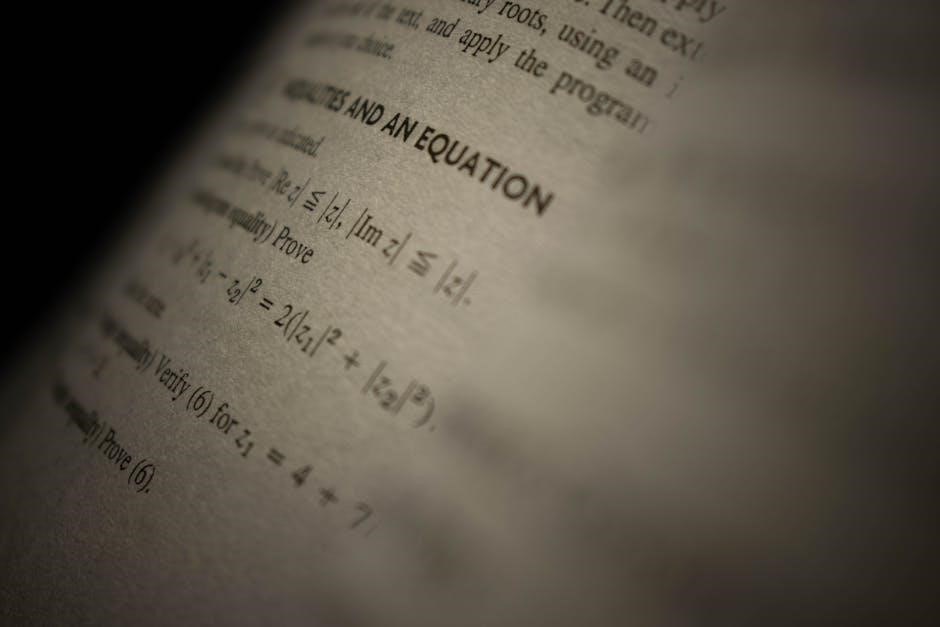
thomas’ calculus 15th edition pdf
Get instant access to Thomas’ Calculus 15th Edition PDF. Download the high-quality textbook now from a trusted source.
Thomas Calculus 15th Edition is a comprehensive textbook that provides a clear and precise introduction to single-variable and multivariable calculus, emphasizing conceptual understanding and modern applications. Its structured approach supports STEM students in developing a deep grasp of mathematical principles, making it a widely-used resource for calculus education.
Overview of the Textbook
Thomas Calculus 15th Edition is a comprehensive textbook designed for STEM students, offering a modern introduction to calculus. It focuses on conceptual understanding, with clear explanations and updated applications. The textbook includes detailed chapters on functions, limits, derivatives, integrals, and their applications, ensuring a robust foundation for learners. Enhanced exercises, revised figures, and improved clarity make it accessible for students with varied readiness levels. Available in PDF format, it supports digital learning and provides a structured approach to mastering calculus concepts, aligning with the needs of today’s STEM education.
Importance of the 15th Edition
The 15th edition of Thomas Calculus is significant for its enhanced exercises, revised figures, and updated applications, ensuring clarity and relevance for modern STEM students. It builds on the legacy of George B. Thomas Jr., with contributions from Maurice D. Weir, Joel Hass, and Frank R. Giordano, offering a robust introduction to calculus. The edition supports students with varied readiness levels, providing a comprehensive and accessible learning experience. Its focus on conceptual understanding and real-world applications makes it a valuable resource for both students and instructors, solidifying its place as a leading calculus textbook.
Target Audience and Usage
Thomas Calculus 15th Edition is primarily designed for undergraduate STEM students pursuing degrees in mathematics, engineering, physics, and other science-related fields. It is ideal for those enrolled in single-variable and multivariable calculus courses, offering a clear and structured approach to complex mathematical concepts. The textbook supports students with varying levels of preparedness, providing additional resources for those needing extra support. Its digital availability in PDF format makes it accessible for modern learners, while supplementary materials enhance the learning experience, ensuring readiness for advanced mathematical challenges in academic and professional settings.

Key Features of the 15th Edition
Enhanced exercises, revised figures for clarity, and updated real-world applications ensure a modern and robust learning experience, focusing on conceptual understanding and practical problem-solving skills.
Enhanced Exercises and Problems
The 15th Edition of Thomas Calculus features a wide range of enhanced exercises and problems designed to deepen students’ understanding of calculus concepts. These exercises cover various topics, from basic differentiation and integration to advanced applications, ensuring a comprehensive learning experience. The problems are carefully crafted to challenge students at all levels, fostering critical thinking and problem-solving skills. Additionally, the inclusion of real-world applications in the exercises makes the content more engaging and relevant, helping students connect mathematical concepts to practical scenarios in STEM fields; This robust set of exercises supports varied student readiness, promoting mastery of calculus principles.
Revised Figures and Clarity
The 15th Edition of Thomas Calculus includes revised figures and improved visual representations to enhance clarity and student understanding. The updated artwork and diagrams provide precise illustrations of key concepts, making complex ideas more accessible. Clear labeling and detailed captions ensure that students can follow the flow of mathematical reasoning seamlessly. This attention to visual detail complements the textual explanations, creating a cohesive learning experience. The revisions aim to help students grasp difficult topics, such as limits, derivatives, and integrals, with greater ease and confidence, aligning with the textbook’s focus on conceptual understanding and modern presentation.
Updated Applications and Relevance
The 15th Edition of Thomas Calculus includes updated applications and real-world examples to enhance relevance for modern students. These additions connect calculus concepts to current issues in STEM fields, such as physics, engineering, economics, and biology. The revised content ensures that students can see the practical importance of mathematical principles in solving contemporary problems. By incorporating modern data and scenarios, the textbook bridges the gap between theory and application, making calculus more engaging and meaningful. This focus on relevance prepares students to apply their knowledge in future academic and professional pursuits effectively. Updated applications also reflect the evolving nature of STEM disciplines, ensuring the material remains fresh and applicable.

Structure of the Textbook

Thomas Calculus 15th Edition is organized into seven chapters, progressing from functions and limits to derivatives, integrals, and transcendental functions, ensuring a logical learning sequence.
Chapter 1: Functions
Chapter 1 introduces the fundamental concept of functions, essential for building a strong foundation in calculus. It explores various types of functions, including polynomial, rational, exponential, and logarithmic functions, along with their properties and graphs. The chapter emphasizes the importance of understanding function notation, domain, range, and composition, providing clear explanations and examples to ensure mastery. By focusing on the behavior and transformations of functions, students gain insights into how functions model real-world phenomena. This chapter sets the stage for subsequent topics like limits and derivatives, ensuring a smooth transition into advanced calculus concepts.
Chapter 2: Limits and Continuity
Chapter 2 delves into the core concepts of limits and continuity, foundational to understanding calculus. It begins with the intuitive idea of limits, progressing to the formal definition, and explores techniques for evaluating limits algebraically and graphically. The chapter also explains continuity, emphasizing its relationship with limits and its significance in function behavior. Additionally, it addresses types of discontinuities and their implications. Through clear explanations and exercises, this chapter equips students with the tools to analyze function behavior and prepare for deeper exploration of derivatives and integrals in subsequent chapters.
Chapter 3: Derivatives
Chapter 3 introduces the concept of derivatives, a fundamental tool in calculus for analyzing rates of change and slopes of tangent lines. It begins with the definition of a derivative as a limit and explores various rules for differentiation, such as the power rule, product rule, and quotient rule. The chapter emphasizes understanding the derivative as a function and its applications in optimization, related rates, and curve sketching. Key theorems, including Rolle’s and the Mean Value Theorem, are also covered. Practical exercises and real-world applications reinforce the connection between derivatives and their practical implications, ensuring a solid foundation for further study.
Chapter 4: Applications of Derivatives
Chapter 4 focuses on the practical applications of derivatives, enabling students to solve real-world problems. It explores optimization techniques, such as finding maxima and minima, and covers related rates, which involve analyzing changing quantities over time. The chapter also delves into curve sketching, emphasizing the use of derivatives to determine concavity, points of inflection, and increasing/decreasing intervals. Additionally, it examines motion along a line and related rates problems. These applications highlight the versatility of derivatives in modeling and solving diverse mathematical and scientific challenges, reinforcing their importance in calculus and STEM disciplines.
Chapter 5: Integrals
Chapter 5 introduces the concept of integrals, focusing on both indefinite and definite integrals. It explores the Fundamental Theorem of Calculus, which bridges the gap between differentiation and integration. The chapter provides a thorough understanding of techniques for integration, including substitution, integration by parts, and partial fractions. Additionally, it covers applications of integrals such as calculating areas between curves, volumes of solids of revolution, and work. The text emphasizes clarity and depth, ensuring students grasp the foundational principles of integration, which are essential for advanced calculus topics and real-world problem-solving in STEM fields.
Chapter 6: Applications of Definite Integrals
Chapter 6 delves into the diverse applications of definite integrals, showcasing their practical relevance in various fields. Topics include calculating areas between curves, volumes of solids of revolution using methods like disks, washers, and cylindrical shells, and surface areas. The chapter also explores the centroid of a region and the moment of inertia, providing a solid foundation for real-world problem-solving. With clear explanations and updated examples, this chapter helps students appreciate the power of integrals in modeling and analyzing physical phenomena, preparing them for advanced STEM applications.
Chapter 7: Integrals and Transcendental Functions
Chapter 7 explores the integration of transcendental functions, focusing on logarithmic, exponential, and inverse functions. It introduces techniques for integrating these functions, such as integration by parts and partial fractions. The chapter also covers applications of integrals in modeling growth and decay phenomena, emphasizing the connection between calculus and real-world problems. Clear explanations and updated examples guide students in mastering these essential skills, preparing them for advanced topics in STEM fields. This chapter reinforces the textbook’s emphasis on conceptual understanding and practical relevance.

Benefits for STEM Students

Thomas Calculus 15th Edition provides STEM students with a robust foundation in calculus, emphasizing conceptual understanding, modern applications, and support for diverse skill levels, fostering academic success.
Conceptual Understanding
Thomas Calculus 15th Edition emphasizes conceptual understanding, guiding students beyond formula memorization to grasp underlying mathematical principles. Clear, intuitive explanations and current applications help students develop a profound appreciation for calculus concepts. The text ensures that learners comprehend the “why” behind the calculations, fostering a deeper connection to the subject. By focusing on conceptual clarity, the book prepares STEM students to apply calculus principles effectively in various fields, ensuring a strong foundation for future academic and professional challenges. This approach supports students in building a robust mathematical proficiency tailored to their needs and interests.
Thomas Calculus 15th Edition offers a modern and robust introduction to calculus, tailored for today’s STEM students. It provides clear, intuitive explanations and current applications that engage learners and enhance understanding. The text’s updated approach ensures relevance and accessibility, making complex concepts manageable. By integrating modern teaching methods and real-world examples, it fosters a deeper connection to the material. This edition is designed to meet the evolving needs of students, offering a fresh perspective on calculus while maintaining its rigorous academic standards. Its modern introduction helps students build a strong foundation for advanced studies and practical applications in various fields.
Support for Varied Student Readiness
Thomas Calculus 15th Edition is designed to accommodate students with diverse levels of mathematical preparation. It provides additional support for those who need it through clear explanations and supplementary resources. The textbook includes a range of exercises and examples to cater to different learning paces. This flexibility ensures that students can build a strong foundation in calculus, regardless of their initial readiness. By addressing varied student needs, the 15th Edition creates an inclusive learning environment that promotes success for all learners in STEM fields. This adaptability is a key feature of its updated structure and content.

Availability and Access
Thomas Calculus 15th Edition is widely available in PDF format, accessible through digital libraries, and official platforms, ensuring easy access for students to study efficiently.
PDF Format and Digital Availability
The 15th Edition of Thomas Calculus is readily available in PDF format, ensuring accessibility for students and educators worldwide. Digital libraries and official platforms provide easy access to the textbook, allowing users to download or view the content conveniently. The PDF format retains its formatting across devices, making it ideal for studying on computers, tablets, or smartphones. This digital availability promotes flexibility and efficiency in learning, catering to the needs of modern students who prefer e-learning resources. The PDF version is particularly popular for its portability and readability, enhancing the overall study experience.
Supplementary Resources and Support
The 15th Edition of Thomas Calculus is accompanied by a range of supplementary resources designed to enhance learning and understanding. Online platforms offer interactive tools, video tutorials, and practice problems that complement the textbook. These resources cater to diverse learning styles and provide additional support for complex topics. The digital package includes access to graphing calculators and animated simulations, enabling students to visualize mathematical concepts. Furthermore, instructors can utilize test banks and lecture slides to create engaging classroom experiences. These supplementary materials ensure a well-rounded and dynamic learning environment for STEM students, fostering deeper engagement and academic success.

Authors and Contributions
George B. Thomas Jr. laid the foundation, while Maurice D. Weir, Joel Hass, and Frank R. Giordano modernized the content, enhancing clarity and relevance for contemporary STEM education.
George B. Thomas Jr. and His Legacy
George B. Thomas Jr. is the original author of Thomas Calculus, renowned for his clear and precise explanations. His legacy continues in the 15th Edition, which builds on his foundational work. The textbook maintains his emphasis on conceptual understanding, blending theory with practical applications. Thomas’s approach has shaped calculus education for decades, providing students with a robust framework for mastering mathematical concepts. His contributions remain central to the text’s success, ensuring its relevance for modern STEM learners. The 15th Edition honors his legacy by updating content while preserving his hallmark clarity and rigor.
Maurice D. Weir, Joel Hass, and Frank R. Giordano
Maurice D. Weir, Joel Hass, and Frank R. Giordano have significantly contributed to the 15th Edition of Thomas Calculus, building on George B. Thomas Jr.’s legacy. Their revisions include enhanced exercises, updated applications, and improved clarity, ensuring the text remains a leading resource for STEM students. Weir’s expertise in calculus education, Hass’s contributions to active learning, and Giordano’s insights into modern applications have collectively enriched the textbook. Their work ensures the 15th Edition meets the needs of today’s students, providing a comprehensive and engaging learning experience that aligns with contemporary academic standards.

Reviews and Ratings
Thomas Calculus 15th Edition has received a 4.8/5 rating from 987 reviews, praised for its clear explanations, updated applications, and robust exercises, making it a top choice for STEM students.
Student and Instructor Feedback
Students and instructors praise the 15th Edition for its clarity and depth. The updated exercises and applications are highlighted as particularly beneficial, aiding understanding and engagement. Instructors appreciate the robust supplementary resources, while students value the intuitive explanations that support varied learning needs. The textbook’s ability to balance conceptual understanding with practical applications has made it a favorite among both groups, fostering a positive learning experience for STEM students.
Comparisons with Previous Editions
The 15th Edition of Thomas Calculus builds upon the legacy of its predecessors, introducing enhanced exercises, revised figures, and updated applications. Compared to earlier editions, it offers improved clarity and modernized content while maintaining the precision that defined previous versions. The 15th Edition is notable for its expanded focus on conceptual understanding and its ability to cater to students with varying levels of preparedness. It refines the learning experience, making it more engaging and effective for STEM students. This edition is a clear evolution, blending tradition with innovation to meet contemporary educational needs.
The 15th Edition of Thomas Calculus is a comprehensive and valuable resource for STEM students, offering a modern introduction to calculus with enhanced clarity and updated applications, continuing its legacy as a foundational textbook in mathematics education.

Final Thoughts on the 15th Edition
The 15th Edition of Thomas Calculus stands out as a refined and modern textbook that seamlessly blends traditional calculus concepts with contemporary applications, catering to the evolving needs of STEM students. By incorporating enhanced exercises, revised figures, and updated real-world relevance, this edition ensures a deeper conceptual understanding. Its clear and intuitive explanations make it accessible to students of varying readiness levels, solidifying its position as a cornerstone in calculus education. The digital availability in PDF format further enhances its accessibility, making it a preferred choice for both students and instructors.
Future of Thomas Calculus
Thomas Calculus is poised to remain a leading resource in calculus education, with a focus on adapting to emerging trends in STEM education. Future editions will likely integrate more digital tools and AI-driven learning aids to enhance student engagement. The emphasis on clear explanations and modern applications will continue, ensuring relevance in a rapidly evolving academic landscape. As STEM fields expand, the textbook will evolve to address new mathematical challenges and interdisciplinary connections. Its legacy as a foundational calculus text will endure, supported by ongoing updates and a commitment to fostering deep conceptual understanding among learners worldwide.